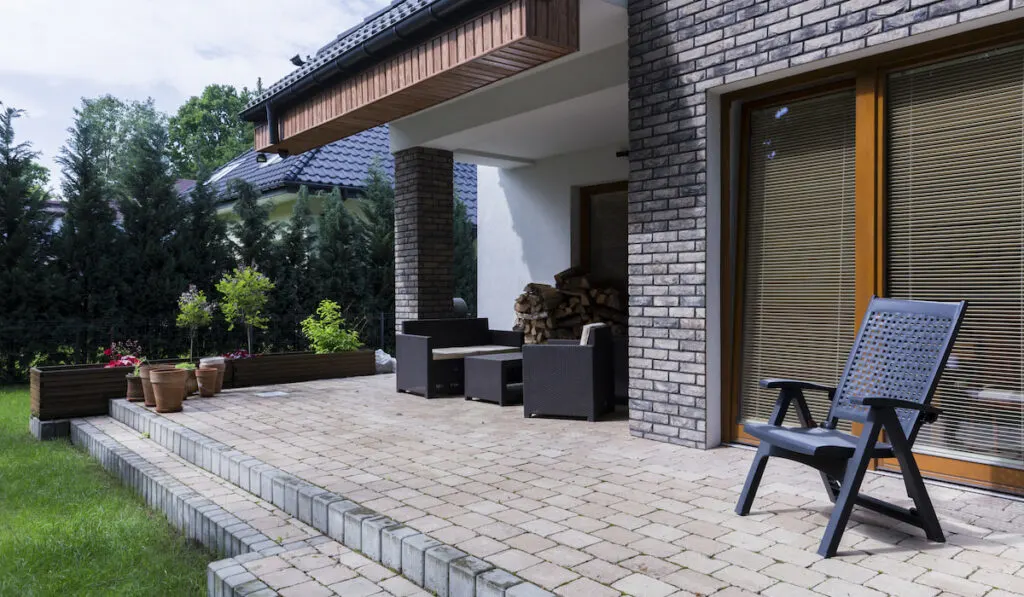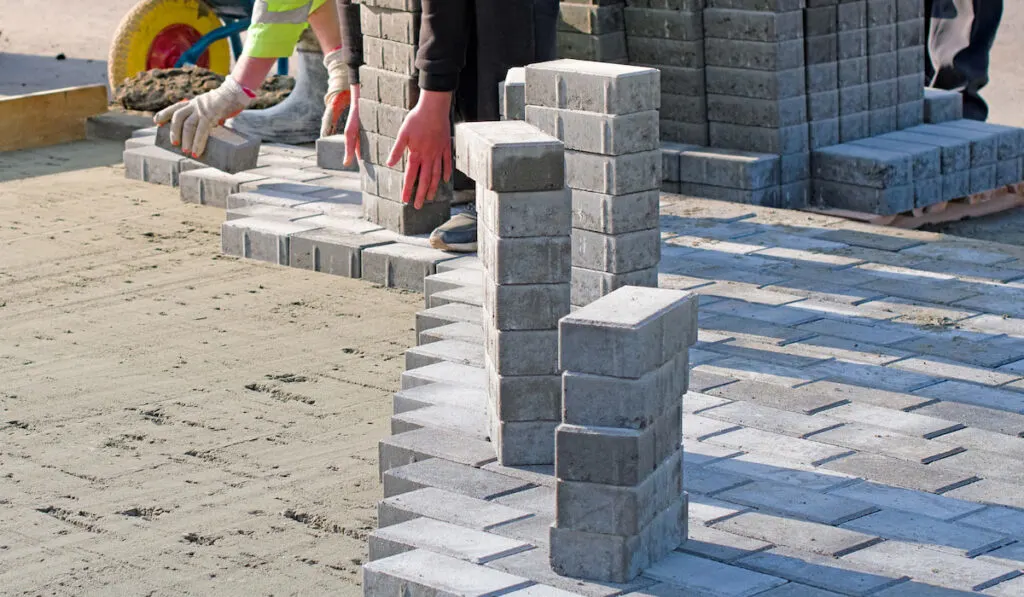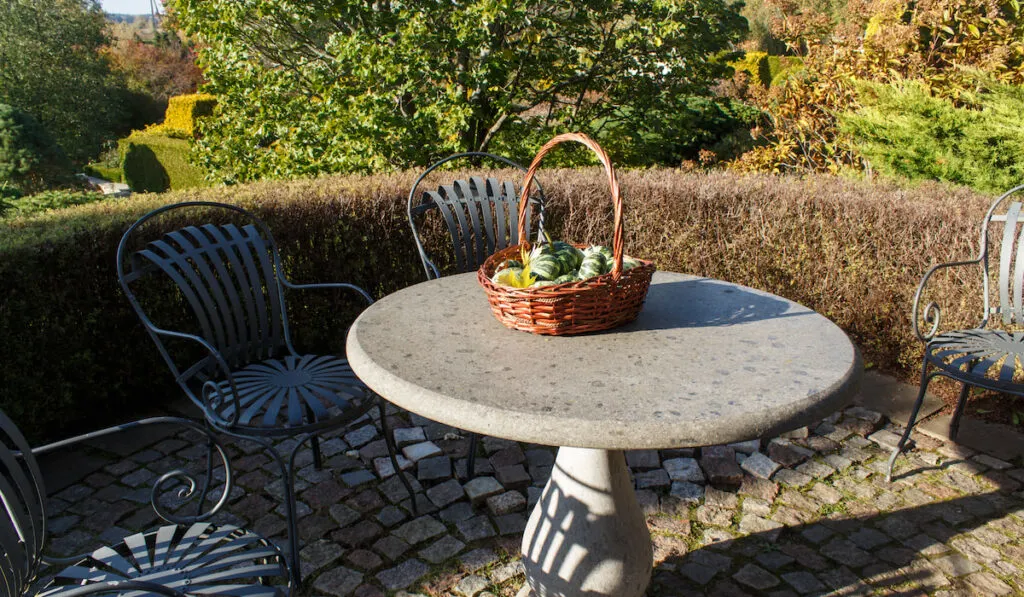*This post may have affiliate links, which means I may receive commissions if you choose to purchase through links I provide (at no extra cost to you). As an Amazon Associate, I earn from qualifying purchases. Please read my disclaimer for additional details.
Patio pavers are a great choice for homeowners because they come in a wide range of colors and styles, and they are a relatively easy DIY project for most homeowners.
Knowing how to install pavers, including how far to space them from one another, can make a huge difference in how your project turns out.

Opinions vary, but the consensus is that patio pavers should be one-eighth to one-half inches apart. However, based on the style and pattern of the pavers you are using and the joint filler you choose, you could space your pavers up to 1 ½ inches apart.
If you are using pavers to build a patio, they will need to be much closer than if they are just to be stepping stones. We’ll cover both uses just to be sure you understand the difference.
Throughout the next few sections, we’ll explain why it’s important to space your pavers and how to do it like the pros.
Table of Contents
How to Space Patio Pavers?
Contractors and other professions will place pavers anywhere from 1/8 of an inch to 1 ½ inches apart depending on the desired effect. If you are doing the project yourself, follow their lead on this.
When you start a patio project, the first thing you’ll need to do is level out the area where your pavers will go. This step is tedious, but it makes a huge difference in how the end result will look.
It’s also much easier to tell how far apart should patio pavers be when you have a nice, level surface to work with.
If you don’t space the pavers properly, you’ll end up with one or more of the following problems:
- Unattractive results – The finished patio won’t have that professional appearance if there are irregular spaces between the pavers.
- Grass and weeds – If you want to prevent grass and weeds from growing up between your pavers, they should be placed close together or sealed with an effective compound.
- Uneven surface – Irregular spaces between patio pavers result in a surface that’s dangerous to walk on.
Placing pavers evenly results in a low maintenance, safe, beautiful patio. If you’d like to know how to lay patio pavers like a pro, watch this short video.
Pavers for a Patio

So, how do you decide exactly how far apart to place your pavers? A lot of that decision depends on how large your pavers are. Here’s what we recommend:
Smaller spaces between pavers (less than 1 ½ inches)
As a general rule, smaller pavers require smaller spaces between them. Proportions are a major factor in all design elements.
Smaller gaps between pavers look better with intricate patterns because they make it easier to see the pattern. It will also be easier for you or whoever is placing the pavers to maintain these smaller spaces and keep the pattern consistent.
Finally, it is more economical to seal between pavers with small spaces because it requires less filler material.
Larger spaces (over 1 ½ inches)
We haven’t discussed big spaces between pavers yet, but there are times when a big space is more appropriate. For example, big spaces between large pavers look great for modern, geometric designs. This concept looks very neat with grass between the pavers.
For this effect to be functional, you just have to place the pavers deep enough that you can mow over them. Or, if you are trying to eliminate some mowing time, pack small gravel in the spaces instead for the same look.
Larger spaces work best with extra-large pavers for proportion’s sake — just like we talked about above.
You may not be used to seeing large gaps between pavers, but it’s a great way to cover a lot of ground.
Pavers as Stepping Stones

Patio pavers can also be used as stepping stones leading to your patio or porch.
This directs guests where you want them to walk, and it makes the path visible and sturdy for those with mobility issues.
In this case, you will need to space the pavers out about 24 inches from the middle of one paver to the middle of the next one. This distance accommodates most people’s natural stride.
Of course, you can combine the two concepts — stepping stones and a patio appearance — and make a walkway of tightly placed pavers. Especially if this walkway leads to a patio or pool with similar stone work, it is an easy, relatively cheap way to increase your property value and curb appeal.
Many people choose to do their walkways with this technique, using one pattern for the actual walkway and a different pattern or stone for the edges, creating a one-of-a-kind pathway.
Filling Space Between Pavers
Pavers will get loose and move around if they don’t have a filler between them. The spaces you leave between them will house the filler material, and over time, the pavers and filler will settle and solidify to form a flat, uniform surface.
Below, we’ll briefly go over the process for filling the spaces between your pavers with 3 of the most popular fillers:
Polymeric sand

Regular sand isn’t used much anymore for patios because it washes away too easily. This makes the patio surface look bad, and it affects how well the patio drains, which can cause flooding or water damage in your home.
Polymeric sand is formulated to harden over time rather than eroding with normal precipitation. This type of sand will eventually act like concrete between the pavers.
To spread polymeric sand, pour it out in small sections over the pavers you have already placed, and spread it with a broom or garden hoe.
When it is all spread out, gently spray the surface of the patio with a garden hose to rinse excess sand into the gaps.
You may have to repeat this process 1 or 2 more times to completely fill the spaces between your pavers.
Gravel
Small gravel, known as pea gravel because of its size, looks very nice when used between patio pavers. You can match the color of your pavers or contrast it with pea gravel for a nice visual effect.
The smallest gravel you can buy is 1B. These stones have a diameter of ¼ to ½ inch, but larger pea gravel will work as well.
Gravel can be spread in much the same way as polymeric sand, but you will probably need a garden rake to spread it.
Grass

Grass is by far the easiest patio filler to use. All you have to do is place the pavers without any plastic or paper underneath and let nature take its course.
What We Learned
The question of how far apart should patio pavers be is not a one-dimensional answer. To accurately answer the question, you need to know what size pavers you will be working with, how you plan to fill the spaces between the pavers, and what your personal preferences are for the appearance of the finished product.
As long as you leave a small space (one-eighth of an inch up to half an inch), you can’t go wrong. The patio will look nice and consistent, and you won’t see premature wear and tear.
But if you want to explore some more unique patio designs, you can opt for larger spaces between your pavers and fill them with gravel or let grass surround them.
References
https://sspavers.com/how-far-apart-to-space-pavers/
https://www.sakrete.com/blog/post/applying-polymeric-sand-to-an-existing-patio-or-walkway/#:~:text=Polymeric%20Sand%20is%20a%20blend,concrete%20pavers%20and%20brick%20pavers.
